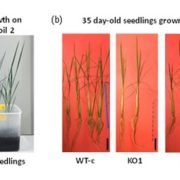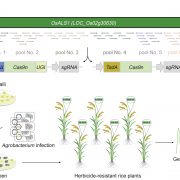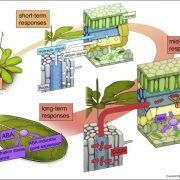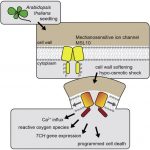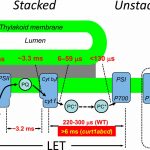Vacuolar channel CLCa is involved in guard cell pH homeostasis (PNAS)
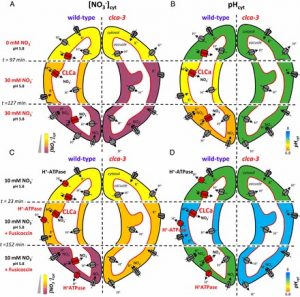 In plants, stomata are involved in a host of responses, controlled by ion homeostasis in guard cells. In an attempt to understand the function of a plant chloride channel (CLC), CLCa, which transports chloride (Cl–) and nitrate (NO3–) in guard cells, Demes and colleagues sought to establish a relationship between ion transport and pH regulation by the channel. To this end, they used a fluorescent sensor named ClopHensor, developed for use in mammalian cells. Briefly, it uses a chloride- and pH-sensitive GFP that is fused to DsRed. Excitation with different wavelengths of light and ratiometric analysis allow for the simultaneous measurement of Cl– (or other anions), and pH. In plant cells, the authors found that ClopHensor is a good indicator for the concentration of NO3–, but not sensitive to the physiological levels of Cl– . They then used this probe to explore how guard cells behave when the vacuolar chloride channel is knocked out. In wild-type plants, the authors found that NO3– uptake directly correlates with acidification of guard cell cytosol. Contrarily in clca mutants, it was found that there is no significant acidification upon addition of NO3–, hinting at a role for NO3‑/H+ exchange activity of CLCa. Going deeper, the authors applied fungal toxin fusicoccin, which activates the plasma-membrane H+ pump, to wild type and mutant guard cells; while the pH in both increased after fusicoccin treatment, that of mutant plants failed to recover, showing that CLCa can induce changes in pH (through H+ transport) independent of anion transport. (Summary by Pavithran Narayanan @pavi_narayanan) Proc. Natl. Acad. Sci. USA
In plants, stomata are involved in a host of responses, controlled by ion homeostasis in guard cells. In an attempt to understand the function of a plant chloride channel (CLC), CLCa, which transports chloride (Cl–) and nitrate (NO3–) in guard cells, Demes and colleagues sought to establish a relationship between ion transport and pH regulation by the channel. To this end, they used a fluorescent sensor named ClopHensor, developed for use in mammalian cells. Briefly, it uses a chloride- and pH-sensitive GFP that is fused to DsRed. Excitation with different wavelengths of light and ratiometric analysis allow for the simultaneous measurement of Cl– (or other anions), and pH. In plant cells, the authors found that ClopHensor is a good indicator for the concentration of NO3–, but not sensitive to the physiological levels of Cl– . They then used this probe to explore how guard cells behave when the vacuolar chloride channel is knocked out. In wild-type plants, the authors found that NO3– uptake directly correlates with acidification of guard cell cytosol. Contrarily in clca mutants, it was found that there is no significant acidification upon addition of NO3–, hinting at a role for NO3‑/H+ exchange activity of CLCa. Going deeper, the authors applied fungal toxin fusicoccin, which activates the plasma-membrane H+ pump, to wild type and mutant guard cells; while the pH in both increased after fusicoccin treatment, that of mutant plants failed to recover, showing that CLCa can induce changes in pH (through H+ transport) independent of anion transport. (Summary by Pavithran Narayanan @pavi_narayanan) Proc. Natl. Acad. Sci. USA


